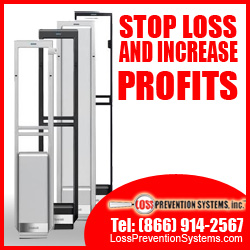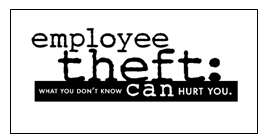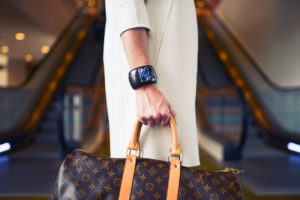 One of the most prevalent crimes in the United States is shoplifting. While many state governments and lawmakers have taken a strong approach to combat shoplifting, it is a battle that keeps the retail industry checking their loss prevention measures, and their ability to combat this crime.
One of the most prevalent crimes in the United States is shoplifting. While many state governments and lawmakers have taken a strong approach to combat shoplifting, it is a battle that keeps the retail industry checking their loss prevention measures, and their ability to combat this crime.
According to the National Association for Shoplifting Prevention, (NASP) the retail industry loses approximately $35 million per day. Even when advances in technology have aided the loss prevention team in combating this crime, figures about shoplifting has shown an increase in the average inventory shrink rate to 1.44 percent.
The average shrink rates take into consideration shoplifting, internal theft, vendor or merchant errors and administrative errors. And although shoplifting accounts for more than a third of the losses, internal or employee theft is pretty close behind. An employee that is using the cash register as their personal piggy bank, or an employee that steals merchandise worth hundreds of dollars in one incident can be as detrimental as the shoplifter entering the store and stealing merchandise from the shelves.
How can you prevent or combat shoplifting in your store?
Training – One of the best measures for the prevention of shoplifting is training the loss prevention team and management of the store to spot and react accordingly when witnessing a theft. If a theft is happening and a trained employee is a witness to the incident, merchandise can be salvaged and the shoplifter can be apprehended without having the incident escalate to violence.
Hiring – Background checks before hiring an employee can save you time and money. An employee with a clean employment record can be hired and trained and become an asset to the business right away. According to the 2014 Industry Training Report, small companies with less than 1,000 employees spent an average of $1,238 per training per employee that year. If the new employee is not properly checked or interviewed, the company might lose money and labor that eventually translates into loses for the business and their ability to grow.
Customer Service – The research regarding this important area in the retail industry is unanimous in their findings. Better customer service means less theft. Not only that, but better customer service translates into more profits. Happy customers can be an asset to any business. Good PR can mean more sales, more customers and more profits.
Shoplifting System – Installing a shoplifting system in your store is part of a solution to the problem, not a whole solution by itself. The system will discourage thieves and employees from taking merchandise out of the store without paying, and that is an advantage you cannot do without.
If you are interested in installing a shoplifting system, training your personnel, or using background checks to perfect hiring, call us. We are a company dedicated to providing stores and other businesses the tools necessary to succeed.
 NO! not yet. Before we begin patting ourselves on the back you must remember that your Sensormatic System is only part of your shoplifting solution. Your Sensormatic System will protect your merchandise however, many shoplifters are determined and will try to steal anyway. The Sensormatic System itself is a deterrent. Its mere presence will dissuade many shoplifters.
NO! not yet. Before we begin patting ourselves on the back you must remember that your Sensormatic System is only part of your shoplifting solution. Your Sensormatic System will protect your merchandise however, many shoplifters are determined and will try to steal anyway. The Sensormatic System itself is a deterrent. Its mere presence will dissuade many shoplifters.
 Now that fall is upon us it is getting darker earlier. These hours of darkness can bring unique challenges for retail owners. Have you ever considered that it is your responsibility to help keep customers and employees remain safe while they are on your property? It may make sense that you are responsible for employee safety but you are also obliged to help keep customers safe as well. This includes your parking lot and the exterior areas around the building. How do you do this? What do you have to protect against? Good questions and hopefully we can provide you with answers to those questions and suggestions to make your business safer.
Now that fall is upon us it is getting darker earlier. These hours of darkness can bring unique challenges for retail owners. Have you ever considered that it is your responsibility to help keep customers and employees remain safe while they are on your property? It may make sense that you are responsible for employee safety but you are also obliged to help keep customers safe as well. This includes your parking lot and the exterior areas around the building. How do you do this? What do you have to protect against? Good questions and hopefully we can provide you with answers to those questions and suggestions to make your business safer. For a small business owner, bringing sales to their business is not an easy feat.
For a small business owner, bringing sales to their business is not an easy feat. We are excited to announce our partnership with Johnson Controls/Sensormatic. Sensormatic is one of the oldest and largest Electronic Article Surveillance (EAS) manufactures in the world. Loss Prevention Systems has deep loss prevention and EAS experience.
We are excited to announce our partnership with Johnson Controls/Sensormatic. Sensormatic is one of the oldest and largest Electronic Article Surveillance (EAS) manufactures in the world. Loss Prevention Systems has deep loss prevention and EAS experience. Pricing is also a factor. Sensormatic line of systems will fit a wide range of budgets depending on the features you select. We also have people counting, and data reporting. This gives the Retailer important intelligence on customer traffic and flow. We have seen many of our customer’s significantly reduce expenses in both payroll and operating costs by having this data. Store hours can be adjusted and you can adjust staffing to fit the real world.
Pricing is also a factor. Sensormatic line of systems will fit a wide range of budgets depending on the features you select. We also have people counting, and data reporting. This gives the Retailer important intelligence on customer traffic and flow. We have seen many of our customer’s significantly reduce expenses in both payroll and operating costs by having this data. Store hours can be adjusted and you can adjust staffing to fit the real world. 


 National retail chain stores often rely on a management team to handle all of the daily operations of a business. These positions vary from company to company but depending on the size and sales volume of that retailer there are different managers to oversee diverse functions. There may be soft lines and hardlines department managers, a freight manager, Human Resource Manager and a store manager. Some stores might only have a sales floor manager, freight manager, and a store manager who also functions as the human resources manager. For an independent business owner, these sub-managers might be a luxury that is not affordable to them. That means it is up to the store manager to oversee all store functions and if an employee calls out that may be one more job the manager fills for a day. This takes me back to an old saying I have heard, “Work smarter, not harder”. It is not possible for a store owner or a single manager to effectively perform all of the tasks associated with running a store every single day. Finding ways to lighten the load and improve efficiency can make life much better for a retail owner.
National retail chain stores often rely on a management team to handle all of the daily operations of a business. These positions vary from company to company but depending on the size and sales volume of that retailer there are different managers to oversee diverse functions. There may be soft lines and hardlines department managers, a freight manager, Human Resource Manager and a store manager. Some stores might only have a sales floor manager, freight manager, and a store manager who also functions as the human resources manager. For an independent business owner, these sub-managers might be a luxury that is not affordable to them. That means it is up to the store manager to oversee all store functions and if an employee calls out that may be one more job the manager fills for a day. This takes me back to an old saying I have heard, “Work smarter, not harder”. It is not possible for a store owner or a single manager to effectively perform all of the tasks associated with running a store every single day. Finding ways to lighten the load and improve efficiency can make life much better for a retail owner. Maybe you have seen it before and never gave it much thought, you walked by a cash register and saw a gift card lying next to it. A customer probably just changed their mind, right? Perhaps you saw your salesfloor person wearing a heavy jacket while working but you just attributed it to them being cold all the time. You may notice cash shortages periodically but they are under $10 and some people get busy and make little mistakes, it happens. Then there is the cashier that seems to be really interested in the store and always reports suspicious people he sees. He even asks managers if there might be security camera footage that could be reviewed to see the “suspect” in case they return. There is the saleswoman who finds a lot of empty packages on the floor and reports them to the manager and where she found them so managers would know about theft taking place in the store. These each seem like harmless issues on the surface but could there be something more nefarious going on under your nose? Is something starting to seem a bit curious after all? If you are suspecting something dishonest may be going on in your store what is your next step?
Maybe you have seen it before and never gave it much thought, you walked by a cash register and saw a gift card lying next to it. A customer probably just changed their mind, right? Perhaps you saw your salesfloor person wearing a heavy jacket while working but you just attributed it to them being cold all the time. You may notice cash shortages periodically but they are under $10 and some people get busy and make little mistakes, it happens. Then there is the cashier that seems to be really interested in the store and always reports suspicious people he sees. He even asks managers if there might be security camera footage that could be reviewed to see the “suspect” in case they return. There is the saleswoman who finds a lot of empty packages on the floor and reports them to the manager and where she found them so managers would know about theft taking place in the store. These each seem like harmless issues on the surface but could there be something more nefarious going on under your nose? Is something starting to seem a bit curious after all? If you are suspecting something dishonest may be going on in your store what is your next step?
 The retail industry loses an approximate $45 billion a year due to shoplifting, organized retail crime, merchant, and clerical errors. For the small retail owner, any loss due to shoplifting puts a financial strain on their ability to do business, hire more personnel or invest and grow their business.
The retail industry loses an approximate $45 billion a year due to shoplifting, organized retail crime, merchant, and clerical errors. For the small retail owner, any loss due to shoplifting puts a financial strain on their ability to do business, hire more personnel or invest and grow their business. You think that you may be scoring a great deal on cheap, knock-off Electronic Article Surveillance (EAS) hard tags and labels, however, over time you find that you are missing shoplifters due to poor pick rates or hard tags that are easy to defeat. Why? To make real, quality EAS hard tags and labels it takes more effort and time. The materials and sophistication of the circuit is not something that can be easily done by a slave laborer in some dark factory in a third world nation. The labels we sell are all high-quality EAS labels and tags that are both Sensormatic and Checkpoint Systems compatible.
You think that you may be scoring a great deal on cheap, knock-off Electronic Article Surveillance (EAS) hard tags and labels, however, over time you find that you are missing shoplifters due to poor pick rates or hard tags that are easy to defeat. Why? To make real, quality EAS hard tags and labels it takes more effort and time. The materials and sophistication of the circuit is not something that can be easily done by a slave laborer in some dark factory in a third world nation. The labels we sell are all high-quality EAS labels and tags that are both Sensormatic and Checkpoint Systems compatible.